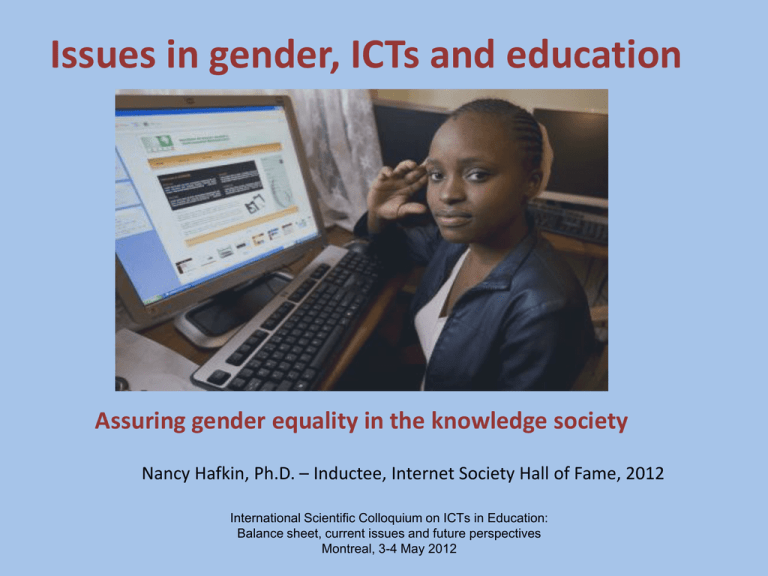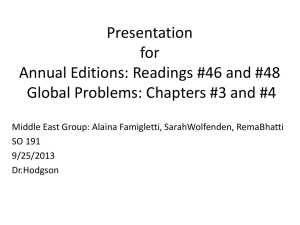
Issues in gender, ICTs and education
Assuring gender equality in the knowledge society
Nancy Hafkin, Ph.D. – Inductee, Internet Society Hall of Fame, 2012
International Scientific Colloquium on ICTs in Education:
Balance sheet, current issues and future perspectives
Montreal, 3-4 May 2012
Science, Technology and Innovation (STI) are
essential for knowledge society, and . . .
ICTs are the
sine qua
non tool of
the
knowledge
society
Cinderella . . .
• Works in the basement of
the knowledge society (if
she works in it at all)
– Has little opportunity
to reap its benefits.
– Waits for "her prince"
to decide the benefits
she will receive.
While
Cyberella
is . . .
•Fluent
in the uses of technology
•Comfortable
using & designing
computers, technology,
communication equipment, software,
working in virtual spaces
•Devises
innovative uses for
technologies
•Finds
information and knowledge to
improve her life and expand choices
•Active
knowledge creator and
disseminator
•More
than a user, designs
information and knowledge systems
to improve all aspects of her life.
The leaky pipeline in S&T education
• There are fewer girls and
women in science and
technology education at
each successive
educational (and
employment) level
• Gender gap widens
ascending the educational
ladder
• More girls now in
secondary and tertiary
education, but few in S&T,
especially computer
science
The women can’t do science debate
• Are males innately better at
science (and ICT?) than females?
• Brought to the fore by Lawrence
Summers, Harvard (2005)
• Said to be partly due to possible
innate shortcomings in math
•
•
•
Elizabeth Spelke: no basic early differences in number
skills between girls and boys
Anything that emerges later is socially determined
Conclusion: girls can learn to use ICTs as well as boys
Some reasons why . . .
Girls’ lack of comfort or
interest in S&T
Even where teenage girls use
computers and the Internet
at similar rates to boys, they
are five times less likely to
consider a technologyrelated career.
Attitudes about what is
appropriate for girls
It is harder/less common to
combine computer-assisted
learning with subjects in
which girls’ tend to be more
interested
Learner confidence
• Boys tend to dominate computerrelated tasks and discussions in
class
• Girls tend to have more anxiety
about computers than boys, but
• Girls tend to underestimate their
technology skills (while boys tend
to overestimate them)
• Girls’ comfort level with computers
increases with experience
• Males frequently denigrate the
technological skills of females
• Given economic and practical
realities of poor countries,
sometimes girls overcome
traditional barriers to study in
these fields
Interest in computers
•Girls often have less interest in computers (and, sometimes,
math and science) than boys
•Age factors: as girls grow older, they tend to decline in
interest in computers
•Gender bias in technology comes from teachers, parents, the
media, association of computer culture with males
•Boys tend to have more positive feelings about computers
than girls
• Computer/video games are
marketed to boys; playing these
games as children increases their
comfort with computers
• Class factors also impact: parents
with higher socio-economic status
and education give more
encouragement about computers
to girls
Learning styles
• Girls tend to prefer collaborative
work (group work) on computers,
while boys prefer to work
individually and competitively
• Boys tend to like technology for
its own sake, whereas girls are
more interested in its
applications
• Different gender-based learning
styles need to be taken into
account
•Much research has been done on whether girls tend to
achieve more on computers in single-sex settings
•no definitive findings have emerged
Role Models
• Girls’ interest & success in these fields is constrained by
lack of female role models, particularly teachers
• However, girls do well with mentors of either sex
•Male teachers tend to use
computers as learning tools
more frequently than women
teachers
•Girls/women tend to
continue in computer science
when their teachers (of either
sex) have positive attitudes
toward women students
•Unflattering images of
women geeks
• Software
– tends to be designed with boys, men as the default
• Teachers bias
– both male and female teachers often exhibit bias
against girls’ studying and using computers or favor
boys, treat them differently in class
Access
• Girls often have limited (and
less than boys) access to
computers, in schools, at
home and in public places
• Small numbers of computers
in schools tend to
disadvantage girls if no “fair
use” policies are in place
• Girls experience problems
with physical safety in going to
computer labs/cybercafés at
night
Gender issues in pre-service
teacher education
• Very little research
has been done on
gender and
technology
differences in preservice teacher
education in ICT
Mobile phones and social media
• Overcome social place
disadvantage of computers
• Increasing availability of
broadband, smartphones increases
information availability
• Girls tend to be more active on
social media than boys (girls
tending to excel in communication)
• But, Internet and social media
frequently portray negative and
dangerous (pornography, stalking,
trafficking) images of women
– Other phenomena, such as
bullying, victimize women
– Such images call for schools to
teach critical thinking
• Social media have positive aspects
for education (group study)
Mobile for development
•Mobile education
•delivery of educational services through a mobile phone, frequently
through an application
•Or, use of a mobile phone for education, such as teaching literacy and
numeracy
•mEducation for development deals with both formal and non-formal education
•Targets illiterate and literate
•Controversy about whether it distracts formal learners and makes teachers
redundant
mEducation: bringing formal education
to more girls in developing countries
• Social, economic and cultural reasons often impede the
ability of girls in developing countries to attend school
– This limits their opportunity to develop the capabilities to lead
the lives that they have reason to value (Sen, 1999).
– Limits personal and societal benefits in a knowledge society
• Many reasons limit girls’ ability/mobility to attend school
– School fees, uniforms, preference for boys’ education, lack of
sanitary products, safety in travelling to/from school, cost of
boarding, dangers of living with relatives/domestic servitude
• Blended learning is one possible response to girls’ realizing
the education and mobility capabilities
– Mobile phones especially becoming nearly ubiquitous in
developing countries
External factors in mEducation for girls
Possible constraints:
•Mobile phones can strain interpersonal gender
relations
•Women can suffer invasions of private or
domestic violence for using a phone
•Language of content more daunting to
girls/women than men/boys
•Are those who need it most least likely to have
access (i.e. poor out-of-school girls in rural
areas of Africa)?
Hope for success:
•Especially useful when girls are out of school for
cost and cultural reasons
A successful project: Jokko Initiative
in Senegal
• Teaches literacy in local language, where written
materials largely unavailable
• Affordable handsets chosen with large lettering digital
displays
• Mobile Phone for Literacy and Empowerment
curriculum development (150 hours)
• Digital literacy included (including SMS)
• 80% of participants women
• Spill over effect to neighboring communities
• Success in development of language and literacy skills
Jokko mobile phone education
initiative – Senegal: 3 mo. results
Near doubling of
participants who had
used a mobile phone
Eight-fold increase in
participants who could
send or receive SMS
Eight-fold increase in
those who could read
phone messages
Averaging nine
messages sent per
week
Outcomes/impact
• No consensus that either girls or boys have better
outcomes from computer-assisted learning.
• Girls, however, do seem to gain more in selfesteem than boys from successful computer use
The larger issue: How can the formal education
system remove the barriers that interfere with
girls’ and women’s access to and success in
technology?
Questions/comments?









